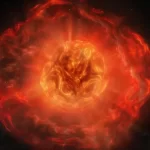Key Takeaways:
- Physicists propose a groundbreaking theory suggesting our Universe might exist within a ‘bubble’ amidst other five-dimensional spaces.
- This concept challenges conventional four-dimensional space-time, positing additional dimensions that form expanding bubbles.
- The theory aims to shed light on the enigmatic ‘dark energy’ driving the constant expansion of our Universe, a longstanding scientific puzzle.
- String theory, a prominent framework in physics, faces challenges in explaining observed phenomena, necessitating new approaches like this bubble hypothesis.
- The study combines concepts from string theory and alternative 5D spaces, offering a potential bridge between theoretical physics and observable reality.
In a bold and mind-bending exploration, physicists from Uppsala University in Sweden have introduced a groundbreaking hypothesis to unravel the enduring enigma of our expanding universe. Their theory suggests that we might be living within a ‘bubble,’ nestled amidst a complex tapestry of five-dimensional spaces that transcend our conventional understanding of the cosmos.
Our typical perception of the universe revolves around four dimensions: the three spatial dimensions (up-down, left-right, back-forth) and one dimension of time. However, this innovative proposition introduces the concept of additional five-dimensional spaces. When two of these five-dimensional spaces intersect, they form an expanding bubble, with our entire universe seemingly accommodated on the periphery of this cosmic bubble.
What’s even more fascinating is the prospect of a multiverse. This theory posits that there could be numerous such bubbles, each representing a distinct universe. This challenges the traditional view of a single, self-contained cosmos.
The central objective of this radical idea is to address the perplexing puzzle of ‘dark energy.’ For decades, scientists have grappled with this theoretical force responsible for the constant expansion of our universe. Previous attempts, including the elegant but flawed string theory, failed to provide a satisfactory solution.
String theory, an alluring concept in physics, emerged from early efforts to incorporate additional dimensions into general relativity. It suggested that fundamental properties of matter, like charge and spin, were consequences of tiny ‘strings’ vibrating in multiple dimensions. However, as the theory evolved, it became increasingly apparent that it was incompatible with our observations of the universe.
This new proposal builds upon an idea introduced approximately two decades ago by American theoretical physicists Lisa Randall and Raman Sundrum. They conceived alternative universe models based on distinct types of 5D spaces merging at points called ‘branes.’ These models aimed to elucidate why gravity appeared weaker compared to other forces.
In this context, the researchers leveraged 5D anti-de Sitter spaces, which differ from our universe by lacking a dominant presence of dark energy and possessing the right type of negative energy. By combining these spaces, they developed a framework to describe the expansion of our 4D universe, complete with particles that transmit the appropriate amount of gravity.
The interplay with string theory is fascinating. The ‘strings’ in string theory, depicted as beams of light, extend from an extra dimension into our universe, imparting it with its unique characteristics. Unlike previous string theory models, this theory remains consistent, thanks to the inclusion of anti-de Sitter spaces. It paints a picture of our universe as a growing bubble with an interior and an exterior in a five-dimensional realm.
While residing on the surface of an inter-dimensional bubble may seem poetic, it remains a speculative concept. Physics is progressing to a point where innovative ideas must be tested against reality. Among these seemingly eccentric notions involving vibrating strings and bubble universes, there may lie conclusions that remarkably align with statistical anomalies observed in particle accelerators or puzzling numerical discrepancies in astronomical observations. Perhaps, in this intriguing mix of concepts, the remnants of string theory will play a role in the next epoch of groundbreaking physics ideas.
This research, brimming with cosmic imagination and intellectual daring, was published in Physical Review Letters.


